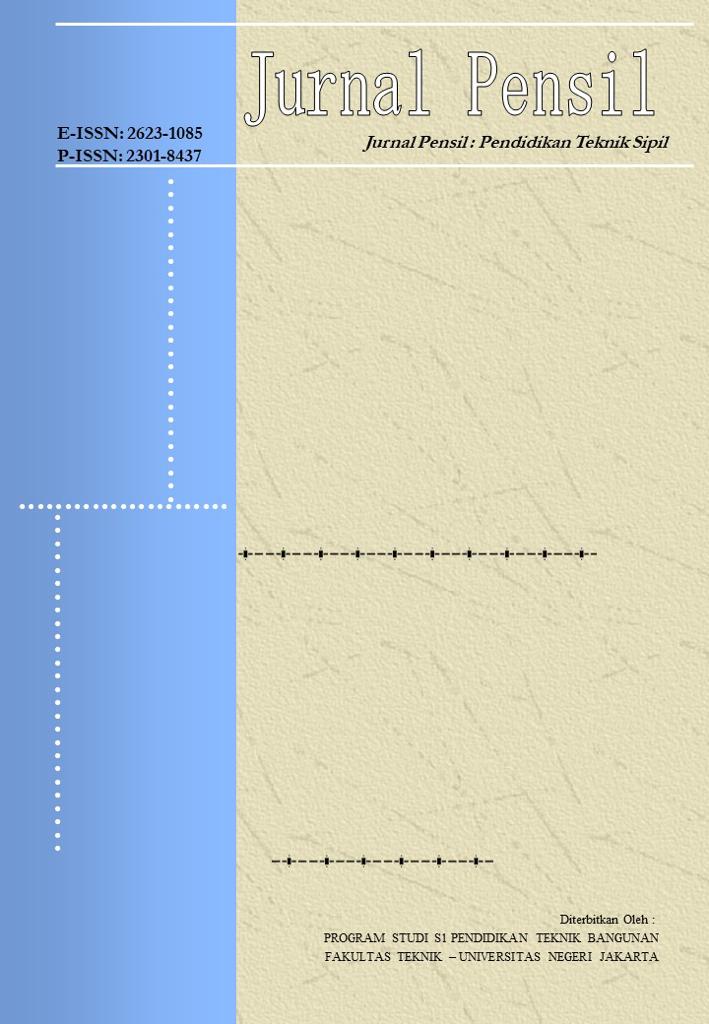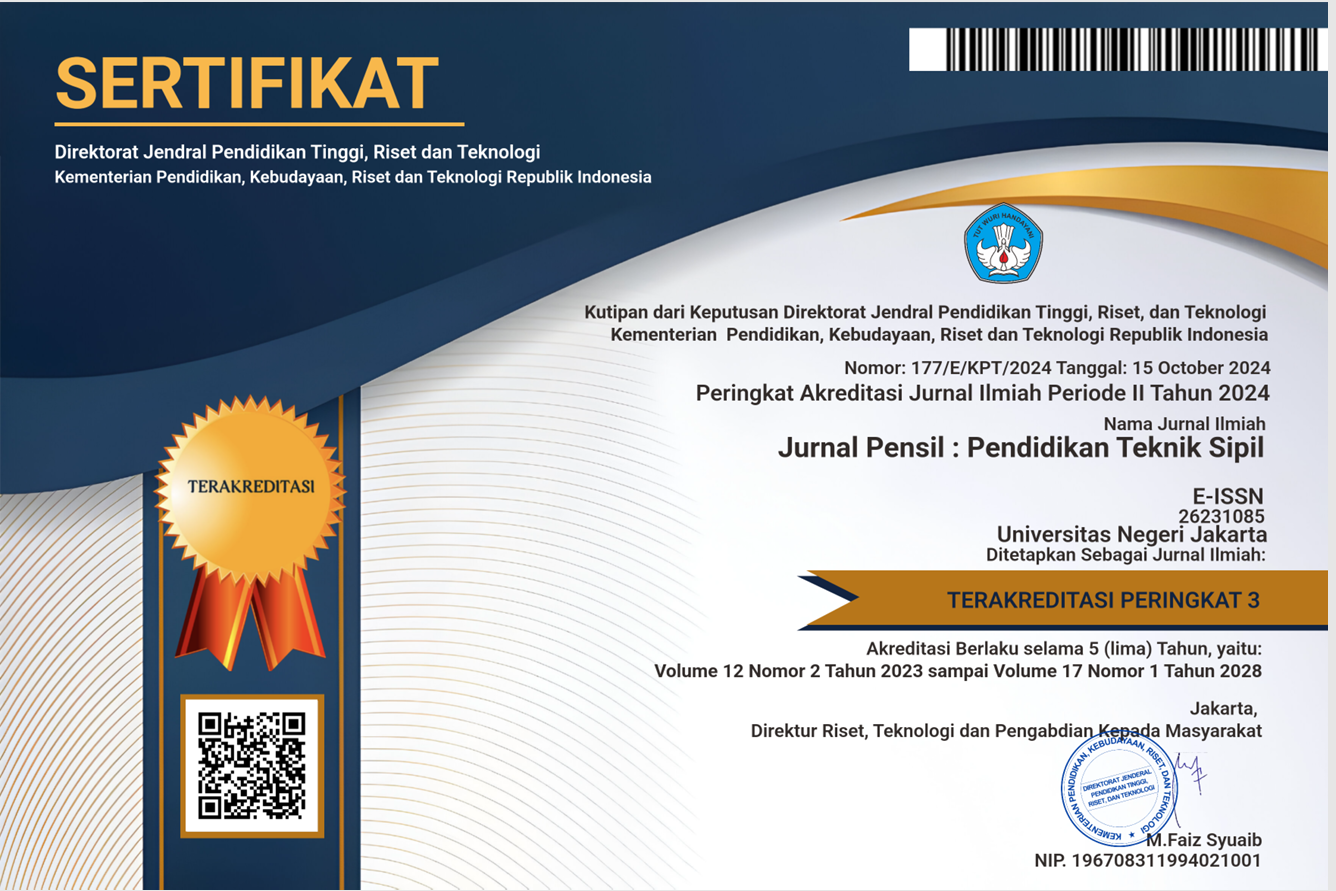CURRENT LITERATURE REVIEW ON IMAGE PROCESSING ANALYSIS FOR CONCRETE DAMAGE ASSESMENT
DOI:
https://doi.org/10.21009/jpensil.v13i3.45042Keywords:
Computer Vision, Concrete Damage, Image ProcessingAbstract
Numerous studies have employed computer vision algorithms to analyze images of concrete damage. Therefore, conducting an image processing survey to detect concrete damage is very crucial. Thus, an image processing algorithm analysis survey to detect concrete damage was conducted using various algorithms and types of data from the last decade. The data observed were the first is damage to concrete, which included surface cracks, hairlines, crack width, patterns, holes, diagonal cracks, longitudinal cracks, and transverse cracks. The second part is figuring out where roads, bridges, and buildings are. The third is data sources like digital cameras, cameras built into phones, camera sensor systems, and unmanned aerial vehicles (UAVs). The study's findings indicate that image processing algorithms will play an essential role in future assessment research on the automation of concrete damage detection. This is particularly the case in high-risk regions for security reasons, and UAV technology is required to reach these locations.
References
Almisreb, A. A., Jamil, N., & Din, N. M. (2018). Utilizing AlexNet Deep Transfer Learning for Ear Recognition. Fourth International Conference on Information Retrieval and Knowledge Management (CAMP), 1–5. https://doi.org/10.1109/INFRKM.2018.8464769
Amhaz, R., Chambon, S., Idier, J., & Baltazart, V. (2014). A new minimal path selection algorithm for automatic crack detection on pavement images A new minimal path selection algorithm for automatic crack detection on pavement images. Open Archive TOULOUSE Archive Ouverte (OATAO). 788–792. https://doi.org/10.1109/ICIP.2014.7025158ï
Amhaz, R., Chambon, S., Idier, J., & Baltazart, V. (2016). Automatic Crack Detection on Two-Dimensional Pavement Images: An Algorithm Based on Minimal Path Selection. IEEE Transactions on Intelligent Transportation Systems, 17(10), 2718–2729. https://doi.org/10.1109/TITS.2015.2477675
An, Q., Chen, X., Wang, H., Yang, H., Yang, Y., Huang, W., & Wang, L. (2022). Segmentation of Concrete Cracks by Using Fractal Dimension and UHK-Net. Fractal and Fractional, 6(2), 95. https://doi.org/10.3390/fractalfract6020095
Andrushia, A. D., Anand, N., Godwin, I. A., & Aravindhan, C. (2018). Analysis of Edge Detection Algorithms for Concrete Crack Detection. International Journal of Mechanical Engineering and Technology (IJMET, 9(11), 689–695. http://www.iaeme.com/IJMET/index.asp689http://www.iaeme.com/ijmet/issues.asp?JType=IJMET&VType=9&IType=11http://www.iaeme.com/IJMET/issues.asp?JType=IJMET&VType=9&IType=11
Bulat, A., & Tzimiropoulos, G. (2016). Human Pose Estimation via Convolutional Part Heatmap Regression (pp. 717–732). https://doi.org/10.1007/978-3-319-46478-7_44
Cho, S., Park, S., Cha, G., & Oh, T. (2018). Development of Image Processing for Crack Detection on Concrete Structures through Terrestrial Laser Scanning Associated with the Octree Structure. Applied Sciences, 8(12), 2373. doi:10.3390/app8122373
Cho, S., Park, S., Cha, G., & Oh, T. (2018). Development of Image Processing for Crack Detection on Concrete Structures through Terrestrial Laser Scanning Associated with the Octree Structure. Applied Sciences, 8(12), 2373. https://doi.org/10.3390/app8122373
Syahrian, N. M., Risma, P., & Dewi, T. (2017). Vision-Based Pipe Monitoring Robot for Crack Detection Using Canny Edge Detection Method as an Image Processing Technique. Kinetik: Game Technology, Information System, Computer Network, Computing, Electronics, and Control, 243–250. https://doi.org/10.22219/kinetik.v2i4.243
Dinakar, P., Sahoo, P. K., & Sriram, G. (2013). Effect of Metakaolin Content on the Properties of High Strength Concrete. International Journal of Concrete Structures and Materials, 7(3), 215–223. https://doi.org/10.1007/s40069-013-0045-0
Dinh, T. H., Ha, Q. P., & La, H. M. (2016). Computer vision-based method for concrete crack detection. 14th International Conference on Control, Automation, Robotics and Vision (ICARCV), 1–6. https://doi.org/10.1109/ICARCV.2016.7838682
El-Sawy, A., EL-Bakry, H., & Loey, M. (2017). CNN for Handwritten Arabic Digits Recognition Based on LeNet-5. Proceedings of the International Conference on Advanced Intelligent Systems and Informatics, 566–575. https://doi.org/10.1007/978-3-319-48308-5_54
Gastaldi, D., & Pace, M. L. (2011). Hydraulic behaviour of calcium sulfoaluminate cement alone and in mixture with Portland cement. https://www.researchgate.net/publication/292267889
Ha, J., Kim, D., & Kim, M. (2022). Assessing severity of road cracks using deep learning-based segmentation and detection. Journal of Supercomputing, 78(16), 17721–17735. https://doi.org/10.1007/s11227-022-04560-x
Hillerborg, A., Mod~er, M., & Petersson, P.-E. (1976). Analysis of crack formation and crack growth in concrete by means of fracture mechanics and finite elements. in cement and concrete research (Vol. 6). Pergamon Press, Inc.
Hoang, N. D. (2018). Detection of Surface Crack in Building Structures Using Image Processing Technique with an Improved Otsu Method for Image Thresholding. Advances in Civil Engineering, 2018. https://doi.org/10.1155/2018/3924120
Hoang, N. D., & Nguyen, Q. L. (2018). Metaheuristic optimized edge detection for recognition of concrete wall cracks: A comparative study on the performances of Roberts, Prewitt, Canny, and Sobel algorithms. Advances in Civil Engineering, 2018. https://doi.org/10.1155/2018/7163580
Hillerborg, A., Mod~er, M., & Petersson, P.-E. (1976). Analysis of crack formation and crack growth in concrete by means of fracture mechanics and finite elements. in cement and concrete research (Vol. 6). Pergamon Press, Inc.
Poursaee, Amir. (2016). Corrosion of steel in concrete structures. Elsevier, Woodhead Publishing.
Shahrokhinasab, E., Hosseinzadeh, N., Monir Abbasi, A., & Torkaman, S. (2020). Performance of image-based crack detection systems in concrete structures. Journal of Soft Computing in Civil Engineering, 4(1), 127–139. https://doi.org/10.22115/SCCE.2020.218984.1174.
Hsieh, Y.-A., Tsai, Y. J., & Asce, M. (2020). Machine Learning for Crack Detection: Review and Model Performance Comparison. https://doi.org/10.1061/(ASCE)
Manjurul Islam, M. M., & Kim, J. M. (2019). Vision-based autonomous crack detection of concrete structures using a fully convolutional encoder–decoder network. Sensors (Switzerland), 19(19). https://doi.org/10.3390/s19194251
Jiang, F., Ding, Y., Song, Y., Geng, F., & Wang, Z. (2023). Automatic pixel-level detection and measurement of corrosion-related damages in dim steel box girders using Fusion-Attention-U-net. Journal of Civil Structural Health Monitoring, 13(1), 199–217. https://doi.org/10.1007/s13349-022-00631-y
Kang, D., & Cha, Y. J. (2018). Autonomous UAVs for Structural Health Monitoring Using Deep Learning and an Ultrasonic Beacon System with Geo-Tagging. Computer-Aided Civil and Infrastructure Engineering, 33(10), 885–902. https://doi.org/10.1111/mice.12375
Khan, S., Rahmani, H., Shah, S. A. A., & Bennamoun, M. (2018). A guide to convolutional neural networks for computer vision (1st ed., Vol. 8). Synthesis lectures on computer vision.
Kim, H., Lee, J., Ahn, E., Cho, S., Shin, M., & Sim, S. H. (2017). Concrete Crack Identification using a UAV Incorporating Hybrid Image Processing. Sensors (Switzerland), 17(9). https://doi.org/10.3390/s17092052
Kim, H., Sim, S. H., & Cho, S. (2015). Unmanned Aerial Vehicle (UAV)-powered Concrete Crack Detection based on Digital Image Processing. International Conference on Advances in Experimental Structural Engineering
Kumar, P., Batchu, S., Swamy S., N., & Kota, S. R. (2021). Real-time concrete damage detection using deep learning for high rise structures. IEEE Access, 9, 112312–112331. https://doi.org/10.1109/ACCESS.2021.3102647
Li, G., Zhao, X., Du, K., Ru, F., & Zhang, Y. (2017). Recognition and evaluation of bridge cracks with modified active contour model and greedy search-based support vector machine. Automation in Construction, 78, 51–61. https://doi.org/10.1016/j.autcon.2017.01.019
Li, S., & Zhao, X. (2019). Image-Based Concrete Crack Detection Using Convolutional Neural Network and Exhaustive Search Technique. Advances in Civil Engineering, 2019. https://doi.org/10.1155/2019/6520620
Liu, Y., & Yeoh, J. K. W. (2021). Automated crack pattern recognition from images for condition assessment of concrete structures. Automation in Construction, 128. https://doi.org/10.1016/j.autcon.2021.103765
Liu, Y., Yeoh, J. K. W., & Chua, D. K. H. (2020). Deep Learning–Based Enhancement of Motion Blurred UAV Concrete Crack Images. Journal of Computing in Civil Engineering, 34(5). https://doi.org/10.1061/(asce)cp.1943-5487.0000907
Liu, Y.-F., Cho, S., Spencer, B. F., & Fan, J.-S. (2016). Concrete Crack Assessment Using Digital Image Processing and 3D Scene Reconstruction. Journal of Computing in Civil Engineering, 30(1). https://doi.org/10.1061/(asce)cp.1943-5487.0000446
Liu, Z., Cao, Y., Wang, Y., & Wang, W. (2019). Computer vision-based concrete crack detection using U-net fully convolutional networks. Automation in Construction, 104, 129–139. https://doi.org/10.1016/j.autcon.2019.04.005
Long, J., Shelhamer, E., & Darrell, T. (n.d.). Fully Convolutional Networks for Semantic Segmentation.
McLaughlin, E., Charron, N., & Narasimhan, S. (2020). Automated Defect Quantification in Concrete Bridges Using Robotics and Deep Learning. Journal of Computing in Civil Engineering, 34(5). https://doi.org/10.1061/(asce)cp.1943-5487.0000915
Meng, X. (2021). Concrete Crack Detection Algorithm Based on Deep Residual Neural Networks. Scientific Programming, 2021. https://doi.org/10.1155/2021/3137083
Mohan, A., & Poobal, S. (2018). Crack detection using image processing: A critical review and analysis. Alexandria Engineering Journal, 57(2), 787–798. https://doi.org/10.1016/j.aej.2017.01.020
Nguyen, H. N., Kam, T. Y., & Cheng, P. Y. (2014). An Automatic Approach for Accurate Edge Detection of Concrete Crack Utilizing 2D Geometric Features of Crack. Journal of Signal Processing Systems, 77(3), 221–240. https://doi.org/10.1007/s11265-013-0813-8
Oliveira, H., & Correia, P. L. (2014). CrackIT - An image processing toolbox for crack detection and characterization. IEEE International Conference on Image Processing (ICIP), 798–802. https://doi.org/10.1109/ICIP.2014.7025160
Ouypornprasert, W., Traitruengtatsana, N., & Kamollertvara, K. (2018). Optimum Partial Replacement of Cement by Rice Husk Ash and Fly Ash Based on Complete Consumption of Calcium Hydroxide. Sustainable Civil Infrastructures, 145–184. https://doi.org/10.1007/978-3-319-61633-9_10
Pimienta, P., Alonso, M. C., McNamee, R. J., & Mindeguia, J. C. (2017). Behaviour of high‐performance concrete at high temperatures: Some highlights. RILEM Technical Letters, 2, 45–52. https://doi.org/10.21809/rilemtechlett.2017.53
Qu, Z., Mei, J., Liu, L., & Zhou, D. Y. (2020). Crack detection of concrete pavement with cross-entropy loss function and improved VGG16 network model. IEEE Access, 8, 54564–54573. https://doi.org/10.1109/ACCESS.2020.2981561
Rabah, M., Elhattab, A., & Fayad, A. (2013). Automatic concrete cracks detection and mapping of terrestrial laser scan data. NRIAG Journal of Astronomy and Geophysics, 2(2), 250–255. https://doi.org/10.1016/j.nrjag.2013.12.002
Ren, Y., Huang, J., Hong, Z., Lu, W., Yin, J., Zou, L., & Shen, X. (2020). Image-based concrete crack detection in tunnels using deep fully convolutional networks. Construction and Building Materials, 234. https://doi.org/10.1016/j.conbuildmat.2019.117367
Ronneberger, O., Fischer, P., & Brox, T. (2015). U-net: Convolutional networks for biomedical image segmentation. Lecture Notes in Computer Science (Including Subseries Lecture Notes in Artificial Intelligence and Lecture Notes in Bioinformatics), 9351, 234–241. https://doi.org/10.1007/978-3-319-24574-4_28
Sellami, A., & Tabbone, S. (2021). EDNets: Deep Feature Learning for Document Image Classification Based on Multi-view Encoder-Decoder Neural Networks. In Document Analysis and Recognition (Vol. 12824, pp. 318–332). Springer, Cham. https://doi.org/10.1007/978-3-030-86337-1_22
Siebert, S., & Teizer, J. (2014). Mobile 3D mapping for surveying earthwork projects using an Unmanned Aerial Vehicle (UAV) system. Automation in Construction, 41, 1–14. https://doi.org/10.1016/j.autcon.2014.01.004
Simonyan, K., & Zisserman, A. (2015). VERY DEEP CONVOLUTIONAL NETWORKS FOR LARGE-SCALE IMAGE RECOGNITION. http://www.robots.ox.ac.uk/
Sohn, H. G., Lim, Y. M., Yun, K. H., & Kim, G. H. (2005). Monitoring crack changes in concrete structures. Computer-Aided Civil and Infrastructure Engineering, 20(1), 52–61. https://doi.org/10.1111/j.1467-8667.2005.00376.x
Song, W., Jia, G., Zhu, H., Jia, D., & Gao, L. (2020). Automated pavement crack damage detection using deep multiscale convolutional features. Journal of Advanced Transportation, 2020. https://doi.org/10.1155/2020/6412562
Su, C., & Wang, W. (2020). Concrete Cracks Detection Using Convolutional NeuralNetwork Based on Transfer Learning. Mathematical Problems in Engineering, 2020. https://doi.org/10.1155/2020/7240129
Swaddiwudhipong, S., Lu, H. R., & Wee, T. H. (2003). Direct tension test and tensile strain capacity of concrete at early age. Cement and Concrete Research, 33(12), 2077–2084. https://doi.org/10.1016/S0008-8846(03)00231-X
Szegedy, C., Reed, S., Erhan, D., Anguelov, D., & Ioffe, S. (2014). Scalable, High-Quality Object Detection. http://arxiv.org/abs/1412.1441
Valença, J., Puente, I., Júlio, E., González-Jorge, H., & Arias-Sánchez, P. (2017). Assessment of cracks on concrete bridges using image processing supported by laser scanning survey. Construction and Building Materials, 146, 668–678. https://doi.org/10.1016/j.conbuildmat.2017.04.096
Wang, J., Zou, R., Colosimo, B. M., Lu, W., Xu, L., & Jiang, X. J. (2021). Characterisation of freeform, structured surfaces in T-spline spaces and its applications. Surface Topography: Metrology and Properties, 9(2). https://doi.org/10.1088/2051-672X/abf408
Wang, X. (2012). Two-parameter characterization of elastic-plastic crack front fields: Surface cracked plates under uniaxial and biaxial bending. Engineering Fracture Mechanics, 96, 122–146. https://doi.org/10.1016/j.engfracmech.2012.07.014
Watts, A. C., Ambrosia, V. G., & Hinkley, E. A. (2012). Unmanned aircraft systems in remote sensing and scientific research: Classification and considerations of use. Remote Sensing, 4(6), 1671–1692. https://doi.org/10.3390/rs4061671
Wang, X. (2012). Two-parameter characterization of elastic-plastic crack front fields: Surface cracked plates under uniaxial and biaxial bending. Engineering Fracture Mechanics, 96, 122–146. https://doi.org/10.1016/j.engfracmech.2012.07.014
Wenshuo Gao, Xiaoguang Zhang, Lei Yang, & Huizhong Liu. (2010). An improved Sobel edge detection. 3rd International Conference on Computer Science and Information Technology, 67–71. https://doi.org/10.1109/ICCSIT.2010.5563693
Wu, D., Zhang, H., & Yang, Y. (2022). Deep Learning-Based Crack Monitoring for Ultra-High Performance Concrete (UHPC). In Journal of Advanced Transportation (Vol. 2022). Hindawi Limited. https://doi.org/10.1155/2022/4117957
Xu, X. J., & Zhang, X. N. (2013). Crack detection of reinforced concrete bridge using video image. Journal of Central South University, 20(9), 2605–2613. https://doi.org/10.1007/s11771-013-1775-5
Yang, Y. sen, Wu, C. lin, Hsu, T. T. C., Yang, H. C., Lu, H. J., & Chang, C. C. (2018). Image analysis method for crack distribution and width estimation for reinforced concrete structures. Automation in Construction, 91, 120–132. https://doi.org/10.1016/j.autcon.2018.03.012
Yang, Y. sen, Yang, C. M., & Huang, C. W. (2015). Thin crack observation in a reinforced concrete bridge pier test using image processing and analysis. Advances in Engineering Software, 83, 99–108. https://doi.org/10.1016/j.advengsoft.2015.02.005
Yang, X., Li, H., Yu, Y., Luo, X., Huang, T., & Yang, X. (2018). Automatic Pixel-Level Crack Detection and Measurement Using Fully Convolutional Network. Computer-Aided Civil and Infrastructure Engineering, 33(12), 1090–1109. https://doi.org/10.1111/mice.12412
Yu, L., He, S., Liu, X., Jiang, S., & Xiang, S. (2022). Intelligent Crack Detection and Quantification in the Concrete Bridge: A Deep Learning-Assisted Image Processing Approach. Advances in Civil Engineering, 2022. https://doi.org/10.1155/2022/1813821
Yusof, N. A. M., Osman, M. K., Noor, M. H. M., Ibrahim, A., Tahir, N. M., & Yusof, N. M. (2018). Crack Detection and Classification in Asphalt Pavement Images using Deep Convolution Neural Network. 8th IEEE International Conference on Control System, Computing and Engineering (ICCSCE), 227–232. https://doi.org/10.1109/ICCSCE.2018.8685007
Zheng, D., Song, W., Fu, J., Xue, G., Li, J., & Cao, S. (2020). Research on mechanical characteristics, fractal dimension and internal structure of fiber reinforced concrete under uniaxial compression. Construction and Building Materials, 258. https://doi.org/10.1016/j.conbuildmat.2020.120351
Zheng, M., Lei, Z., & Zhang, K. (2020). Intelligent detection of building cracks based on deep learning. Image and Vision Computing, 103. https://doi.org/10.1016/j.imavis.2020.103987
Li, S., & Zhao, X. (2019). Image-Based Concrete Crack Detection Using Convolutional Neural Network and Exhaustive Search Technique. Advances in Civil Engineering, 2019. https://doi.org/10.1155/2019/6520620
Downloads
Published
How to Cite
Issue
Section
License
Copyright (c) 2024 Usman Wijaya, Yogi Yulianto, Emon Haryanto

This work is licensed under a Creative Commons Attribution-ShareAlike 4.0 International License.











.png)
.png)
1.png)

